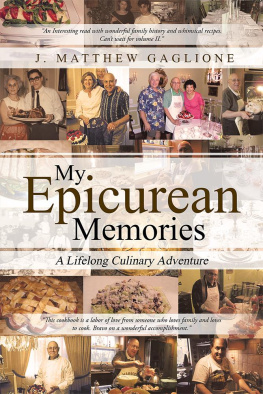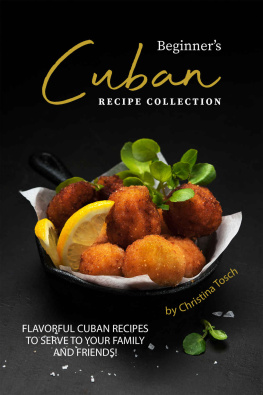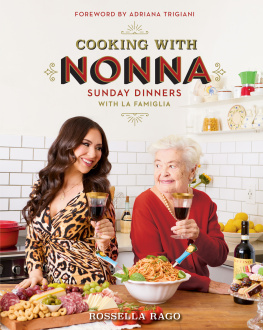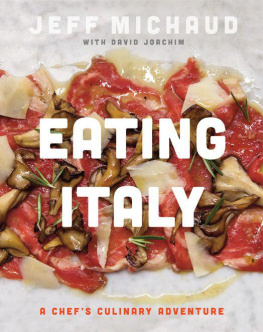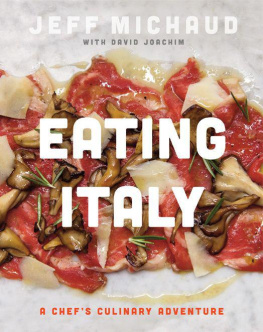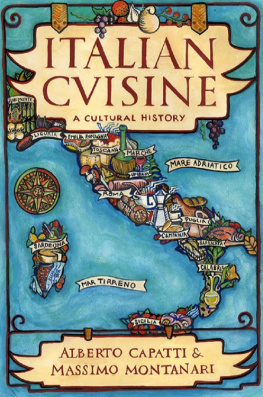My
Epicurean
Memories
A Lifelong Culinary Adventure
J. MATTHEW GAGLIONE

MY EPICUREAN MEMORIES
A LIFELONG CULINARY ADVENTURE
Copyright 2017 J. Matthew Gaglione.
All rights reserved. No part of this book may be used or reproduced by any means, graphic, electronic, or mechanical, including photocopying, recording, taping or by any information storage retrieval system without the written permission of the author except in the case of brief quotations embodied in critical articles and reviews.
iUniverse
1663 Liberty Drive
Bloomington, IN 47403
www.iuniverse.com
1-800-Authors (1-800-288-4677)
Because of the dynamic nature of the Internet, any web addresses or links contained in this book may have changed since publication and may no longer be valid. The views expressed in this work are solely those of the author and do not necessarily reflect the views of the publisher, and the publisher hereby disclaims any responsibility for them.
Any people depicted in stock imagery provided by Thinkstock are models, and such images are being used for illustrative purposes only.
Certain stock imagery Thinkstock.
ISBN: 978-1-5320-1737-7 (sc)
ISBN: 978-1-5320-1738-4 (hc)
ISBN: 978-1-5320-1736-0 (e)
Library of Congress Control Number: 2017903476
iUniverse rev. date: 05/26/2017
Table of Contents
To Richard T. Certofriend, partner, husband, champion
for his encouragement, support, patience, and suggestions
that led to this finished publication
Preface
My epicurean memories begin at an early age. I was raised with my two brothers in a large extended Italian American family in 1950s Brooklyn, New York. My mother, Theresa Ruggiero Gaglione, was a woman ahead of her time. She had a career in an era when married women were expected to stay home and care for their husband and children. Well, she did both!
As a child, I used to watch my mother, my grandmother Antonetta Ruggiero, and my aunts Elvira (El) Gargano and Mary Cantirino in the kitchen. One day I decided, Hey, I can do that! My grandmother was a very hands-on cook and prepared almost everything from scratch. My mother, on the other hand, looked for shortcutsand who could blame her, since her kitchen time was limited. Even with limited time, most frozen and canned foods were verboten in our kitchen. She used her creativity, and we always had tasty and nutritious meals. Eventually, I became her greatest shortcut.
One Sunday when I was about ten, after returning from 8:00 a.m. Mass with my fifth-grade class and before my parents got home from the 10:00 a.m. Mass, I decided to start preparing our Sunday dinnera meal that always included pasta with tomato sauce (not gravy in our family!), meat (usually meatballs, sausage, and/or bracciole), a simple salad, and a green vegetable. When my parents arrived home, I had completed the preparation of the meat for the tomato sauceincluding stuffing the braciola with parsley, pine nuts, and prosciutto and making the meatballs. The tomato sauce was simmering on the stove, water was ready to cook the pasta, the broccoli was ready to steam, and I was just finishing the salad.
My dad was more than surprised. Mom, not so much. I think she had been waiting for the day when she could release the cooking responsibilities, even a little, to me. So my cooking adventures began.
As in most Italian American families, holidays were always big celebrations for us. Thanksgiving, Christmas Eve, Christmas Day, New Years Day, and Easter Sunday were extended family gatherings and called for traditional (excessive) feasts. However, my grandmother, another progressive woman, dictated that because Thanksgiving was an American holiday, no Italian food would be served that day. Roast turkey was king, and a bird of thirty pounds or more was the rule. It was accompanied by a savory stuffing of white and wild rice mixed with beef, pork, veal, celery, and nuts. Side dishes included sweet potatoes, Brussels sprouts, cranberry sauce, and pan gravy. For desserts, there were homemade pumpkin, apple, and mince pies.
Christmas was a different story. Christmas Eve dinner was always at our house, with twenty or more of my mothers family expected. We did not strictly stick to the tradition of Seven Fishes followed by many Italian families, but fish was the order of the day. Preparations began a week prior to the holiday, with a list being dropped off at our local fish market. In those days, most every Brooklyn neighborhood had at least one butcher and fish market. Our Windsor Terrace neighborhood had at least three of each. Mothers order included copious amounts of fish, such as fillet of flounder, shrimp, scallops, clams, smelts, crabmeat, calamari, and sometimes a very aromatic salt cod called Stocco fish, which was stewed in fresh tomato sauce with onions, celery, and black olives.
The menu usually started with either linguine with white clam sauce (no canned clams here) or zuppa di stocco (a specialty of my aunt Mary) and always included fried fillet of flounder, fried shrimp, and scallops, smelts, and crabmeat salad. Calamari was either prepared as a cold salad with celery, capers, and olives or stuffed with tiny shrimp and baked in a light tomato sauce. Side dishes of fried vegetables like artichoke hearts, zucchini, and asparagus were also on the menu. Desserts included strufoli (Auntie Els specialty), Italian pastries, and cookies.
The Christmas Day menu started with an appetizer of paper-thin slices of prosciutto over wedges of cantaloupe, honeydew, or crenshaw melon, followed by a first course of stuffed pasta with meat sauce, such as manicotti, ravioli, or cannelloni. The main course was a baked ham, prime rib of beef, or crown roast of pork, accompanied by side dishes of vegetables like escarole affogati (choked in hot olive oil and garlic) and mushrooms braised with shallots and Madeira wine. Torta ricotta (Italian cheesecake, my mothers and now my specialty) was a special Christmas Day dessert. New Years Day dinner was a similar but smaller feast. Lentils for good luck were always the first course.
Easter Sunday required a dinner as festive as the day. Pizza rustica (a savory cheese-and-meat quiche) was the appetizer. A pasta dish was the first course (usually gnocchi de patate , my grandmothers specialty), followed by roast lamb or crown roast of pork. Spring vegetables were standard and always included steamed artichokes to mark the start of spring. Torta ricotta for dessert and Pane de Pasqua (Italian lard bread) were requisite Easter treats.
As much as I loved cooking and everything that went with it, my professional careerwhich I thoroughly enjoyedtook me in an entirely different direction. I spent thirty-plus years in higher education administration and retired in 2007 from the position of vice provost, student affairs, at the University of Maryland University College. Food and food preparation remained my passion. I began to collect a library of cookbooks, to which I am still adding. One of my first, The Art of Cookery by Emma P. Ewing (copyright 1899), was given to me by my dear friend and former sister-in-law, Nia (Karen). The descriptions and instructions on the preparation of foods I was not familiar with fascinated me. The chapter on How to Manage a Coal Fire was particularly intriguing. I vowed that one day I would cook a meal on a coal stove. So far, the closest Ive gotten is the backyard barbecue!
My passion for cooking extends to all things culinary. Cooking utensils intrigue me, and Ive experimented with every kind of cookware I could lay my hands on. I remember the first Teflon skillets that came out in the 1960s and how Teflon would peel off into your egg omelet. What a disaster! I finally decided that Le Creuset cookware was my personal favorite, followed by copper-clad stainless steel and cast iron for specific uses.
Next page
